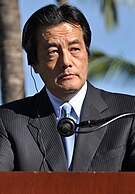Japanese House of Councillors election, 2004
|
|
||||||||||||||||||||||||||||
|---|---|---|---|---|---|---|---|---|---|---|---|---|---|---|---|---|---|---|---|---|---|---|---|---|---|---|---|---|
|
||||||||||||||||||||||||||||
|
121 (73 SNTV, 48 proportional) of 242 seats in the House of Councillors |
||||||||||||||||||||||||||||
|
||||||||||||||||||||||||||||

seats won by
■ - DPJ ■ - LDP ■ - New Komeito |
||||||||||||||||||||||||||||
|
||||||||||||||||||||||||||||
■ - DPJ ■ - LDP ■ - New Komeito
■ - SDP ■ - Independent factions
Hiroyuki Kurata
Liberal Democratic
Chikage Oogi
Liberal Democratic
Elections to the House of Councillors, the upper house of the legislature of Japan, were held on July 11, 2004. The House of Councillors consists of 242 members who serve six-year terms. Approximately half the members are elected every three years. At these elections 121 members were elected. Of these 73 were elected from the 47 prefectural districts and 48 were elected from a nationwide list by proportional representation.
The opposition Democratic Party won a plurality of the popular vote and seats contested in the election, sweeping the liberal urban areas. The ruling Liberal Democratic Party failed to win in its strongholds but once more received most of its support from the agrarian areas. New Komeito did well, reaching its goals, as did the Social Democratic Party. The Japanese Communist Party did not reach its goals, while independents won the rest of the seats. The Liberal League and Midori no kaigi failed to win any seats.
Elected candidates in bold
Compiled from JANJAN's "The Senkyo" and MIC official results.
Notes:
...
Wikipedia


